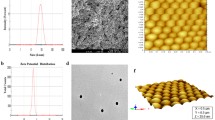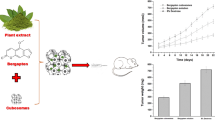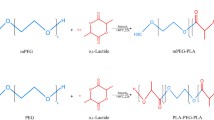Abstract
Purpose
Calcitriol (1,25-dihydroxyvitamin D3), the active metabolite of vitamin D3, is a potential anticancer agent but with high risk of hypercalcemia which limits the achievement of effective serum concentrations. Thus, calcitriol targeting delivery by nanoparticles may present a good solution.
Methods
Vitamin D3 active metabolites were encapsulated into polymeric nanoparticles and different formulation parameters were tested. The growth inhibitory efficiency of these nanoparticles was carried out in vitro on human breast adenocarinoma cells (MCF-7).
Results
Using cholecalciferol (the inactive metabolite), different polymer and oil ratios were compared to select nanoparticles presenting high encapsulation efficiency and sustained release profile. Calcidiol/calcitriol loaded nanoparticles had good encapsulation efficiencies (around 90%) associated with sustained releases over 7 days and enhanced stability. Moreover, loaded nanoparticles showed similar growth inhibition to non-encapsulated metabolites of vitamin D3 on day 4 and higher activities on days 7 and 10 after treatment initiation.
Conclusion
The nano-encapsulation of vitamin D3 active metabolites may offer a new and potentially effective strategy for vitamin D3-based chemotherapy overcoming its actual limitations. The targeting delivery of vitamin D3 metabolites should be encouraged.





Similar content being viewed by others
REFERENCES
Prosser DE, Jones G. Enzymes involved in the activation and inactivation of vitamin D. Trends Biochem Sci. 2004;29:664–73.
Deeb KK, Trump DL, Johnson CS. Vitamin D signalling pathways in cancer: potential for anticancer therapeutics. Nat Rev Cancer. 2007;7:684–700.
Beer TM, Myrthue A. Calcitriol in cancer treatment: from the lab to the clinic. Mol Cancer Ther. 2004;3:373–81.
Gross C, Stamey T, Hancock S, Feldman D. Treatment of early recurrent prostate cancer with 1,25-dihydroxyvitamin D3 (calcitriol). J Urol. 1998;159:2035–9.
Woloszynska-Read A, Johnson CS, Trump DL. Vitamin D and cancer: clinical aspects. Best Pract Res Clin Endocrinol Metab. 2011;25:605–15.
Beer TM, Munar M, Henner WD. A phase I trial of pulse calcitriol in patients with refractory malignancies: pulse dosing permits substantial dose escalation. Cancer. 2001;91:2431–9.
Scher HI, Jia X, Chi K, de Wit R, Berry WR, Albers P, et al. Randomized, open-label phase III trial of docetaxel plus high-dose calcitriol versus docetaxel plus prednisone for patients with castration-resistant prostate cancer. J Clin Oncol. 2011;29:2191–8.
Hughes MR, Baylink DJ, Jones PG, Haussler MR. Radioligand receptor assay for 25-hydroxyvitamin D2/D3 and 1 alpha, 25-dihydroxyvitamin D2/D3. J Clin Invest. 1976;58:61–70.
Townsend K, Evans KN, Campbell MJ, Colston KW, Adams JS, Hewison M. Biological actions of extra-renal 25-hydroxyvitamin D-1alpha-hydroxylase and implications for chemoprevention and treatment. J Steroid Biochem Mol Biol. 2005;97:103–9.
Barreto AM, Schwartz GG, Woodruff R, Cramer SD. 25-Hydroxyvitamin D3, the prohormone of 1,25-dihydroxyvitamin D3, inhibits the proliferation of primary prostatic epithelial cells. Cancer Epidemiol Biomarkers Prev. 2000;9:265–70.
Lou YR, Molnar F, Perakyla M, Qiao S, Kalueff AV, St-Arnaud R, et al. 25-Hydroxyvitamin D(3) is an agonistic vitamin D receptor ligand. J Steroid Biochem Mol Biol. 2010;118:162–70.
Allavena P, Sica A, Solinas G, Porta C, Mantovani A. The inflammatory micro-environment in tumor progression: the role of tumor-associated macrophages. Crit Rev Oncol Hematol. 2008;66:1–9.
Overbergh L, Decallonne B, Valckx D, Verstuyf A, Depovere J, Laureys J, et al. Identification and immune regulation of 25-hydroxyvitamin D-1-alpha-hydroxylase in murine macrophages. Clin Exp Immunol. 2000;120:139–46.
Yokomura K, Suda T, Sasaki S, Inui N, Chida K, Nakamura H. Increased expression of the 25-hydroxyvitamin D(3)-1alpha-hydroxylase gene in alveolar macrophages of patients with lung cancer. J Clin Endocrinol Metab. 2003;88:5704–9.
Mora-Huertas CE, Fessi H, Elaissari A. Polymer-based nanocapsules for drug delivery. Int J Pharm. 2010;385:113–42.
Hillaireau H, Couvreur P. Nanocarriers’ Entry into the cell: relevance to drug delivery. Cell Mol Life Sci. 2009;66:2873–96.
Loomis K, McNeeley K, Bellamkonda RV. Nanoparticles with targeting, triggered release, and imaging functionality for cancer applications. Soft Matter. 2011;7:839–56.
Pavanetto F, Conti B, Genta I, Giunchedi P. Solvent evaporation, solvent extraction and spray drying for polylactide microsphere preparation. Int J Pharm. 1992;84:151–9.
Luca G, Basta G, Calafiore R, Rossi C, Giovagnoli S, Esposito E, et al. Multifunctional microcapsules for pancreatic islet cell entrapment: design, preparation and in vitro characterization. Biomaterials. 2003;24:3101–14.
Nguyen TLU, Tey SY, Pourgholami MH, Morris DL, Davis TP, Barner-Kowollik C, et al. Synthesis of semi-biodegradable crosslinked microspheres for the delivery of 1,25 dihydroxyvitamin D3 for the treatment of hepatocellular carcinoma. Eur Polym J. 2007;43:1754–67.
Sun F, Ju C, Chen J, Liu S, Liu N, Wang K, et al. Nanoparticles based on hydrophobic alginate derivative as nutraceutical delivery vehicle: vitamin D3 loading. Artif Cell Blood Sub. 2012;40:113–9.
Li Q, Liu CG, Huang ZH, Xue FF. Preparation and characterization of nanoparticles based on hydrophobic alginate derivative as carriers for sustained release of vitamin D3. J Agr Food Chem. 2011;59:1962–7.
Fessi H, Puisieux F, Devissaguet JP, Ammoury N, Benita S. Nanocapsule formation by interfacial polymer deposition following solvent displacement. Int J Pharm. 1989;55:R1–4.
Jordheim LP, Guittet O, Lepoivre M, Galmarini CM, Dumontet C. Increased expression of the large subunit of ribonucleotide reductase is involved in resistance to gemcitabine in human mammary adenocarcinoma cells. Mol Cancer Ther. 2005 Aug 1;4(8):1268–76.
Holland SJ, Tighe BJ, Gould PL. Polymers for biodegradable medical devices. 1. The potential of polyesters as controlled macromolecular release systems. J Control Release. 1986;4:155–80.
Teixeira M, Alonso MJ, Pinto MMM, Barbosa CM. Development and characterization of PLGA nanospheres and nanocapsules containing xanthone and 3-methoxyxanthone. Eur J Pharm Biopharm. 2005;59:491–500.
Washington C. Drug release from microdisperse systems: a critical review. Int J Pharm. 1990;58:1–12.
Calvo P, Vila-Jato JL, Alonso MJ. Comparative in vitro evaluation of several colloidal systems, nanoparticles, nanocapsules, and nanoemulsions, as ocular drug carriers. J Pharm Sci. 1996;85:530–6.
Colston KW, Hansen CM. Mechanisms implicated in the growth regulatory effects of vitamin D in breast cancer. Endocr Relat Cancer. 2002;9:45–59.
Segersten U, Holm PK, Björklund P, Hessman O, Nordgren H, Binderup L, et al. 25-Hydroxyvitamin D3 1alpha-hydroxylase expression in breast cancer and use of non-1alpha-hydroxylated vitamin D analogue. Breast Cancer Res. 2005;7:R980–6.
Jin C, Bai L, Wu H, Song W, Guo G, Dou K. Cytotoxicity of paclitaxel incorporated in PLGA nanoparticles on hypoxic human tumor cells. Pharm Res. 2009;26:1776–84.
Goldberg EP, Hadba AR, Almond BA, Marotta JS. Intratumoral cancer chemotherapy and immunotherapy: opportunities for nonsystemic preoperative drug delivery. J Pharm Pharmacol. 2002;54:159–80.
Al-Ghananeem AM, Malkawi AH, Muammer YM, Balko JM, Black EP, Mourad W, et al. Intratumoral delivery of paclitaxel in solid tumor from biodegradable hyaluronan nanoparticle formulations. AAPS Pharm Sci Tech. 2009;10:410–7.
Bernardi A, Braganhol E, Jäger E, Figueiró F, Edelweiss MI, Pohlmann AR, et al. Indomethacin-loaded nanocapsules treatment reduces in vivo glioblastoma growth in a rat glioma model. Cancer Lett. 2009;281:53–63.
Almouazen E, Bourgeois S, Boussaïd A, Valot P, Malleval C, Fessi H, et al. Development of a nanoparticle-based system for the delivery of retinoic acid into macrophages. Int J Pharm. 2012;430:207–15.
Author information
Authors and Affiliations
Corresponding author
Rights and permissions
About this article
Cite this article
Almouazen, E., Bourgeois, S., Jordheim, L.P. et al. Nano-encapsulation of Vitamin D3 Active Metabolites for Application in Chemotherapy: Formulation Study and in Vitro Evaluation. Pharm Res 30, 1137–1146 (2013). https://doi.org/10.1007/s11095-012-0949-4
Received:
Accepted:
Published:
Issue Date:
DOI: https://doi.org/10.1007/s11095-012-0949-4




